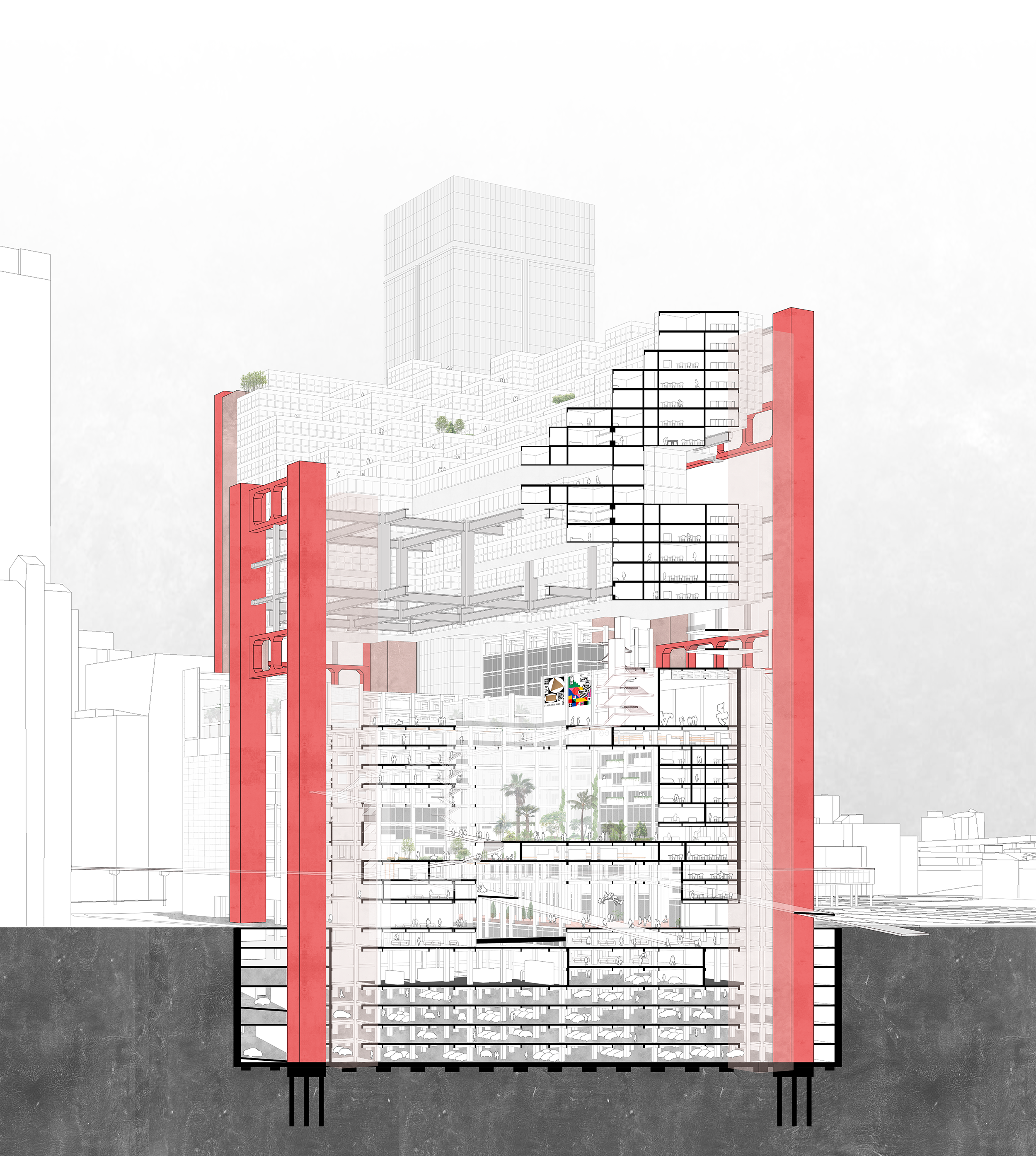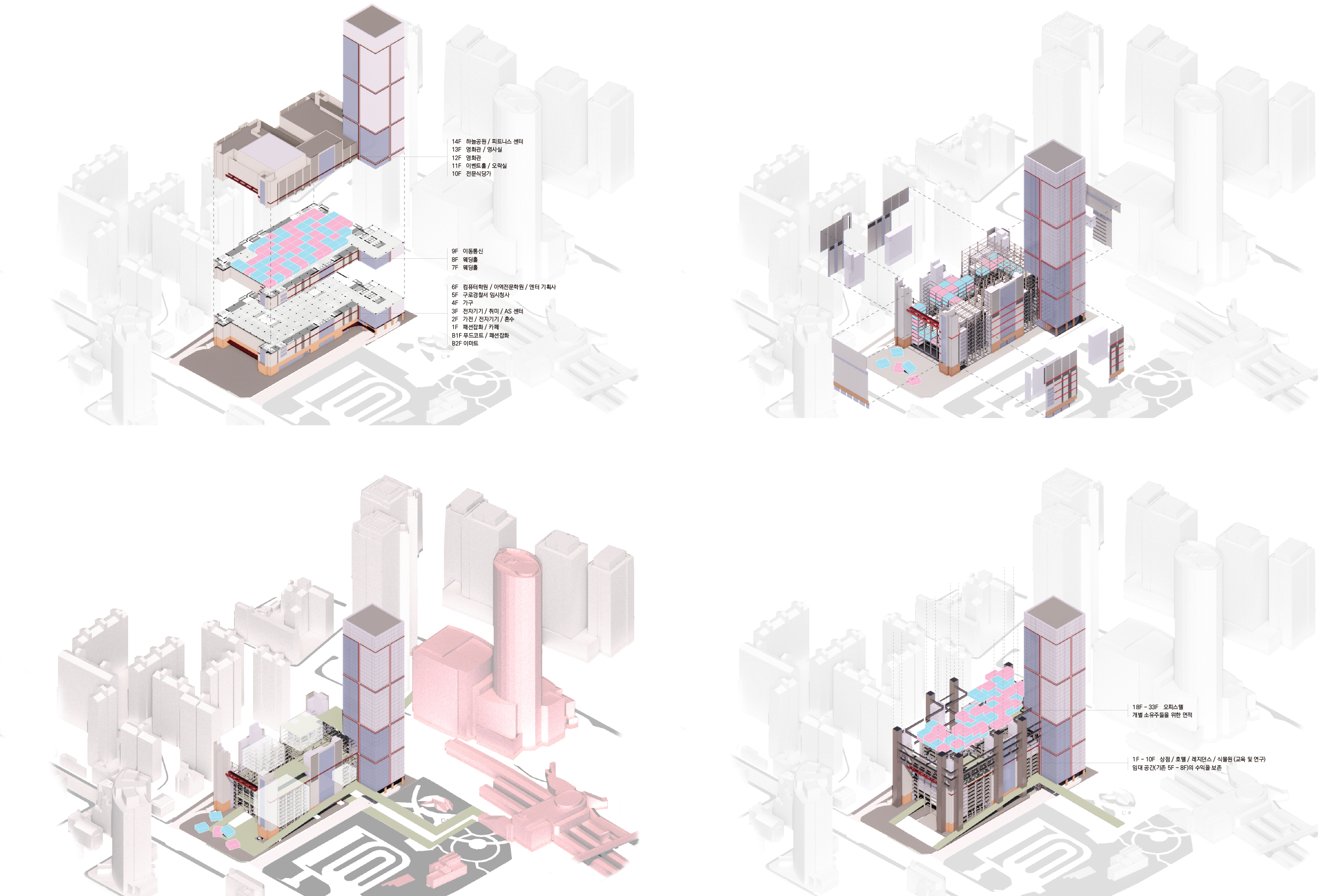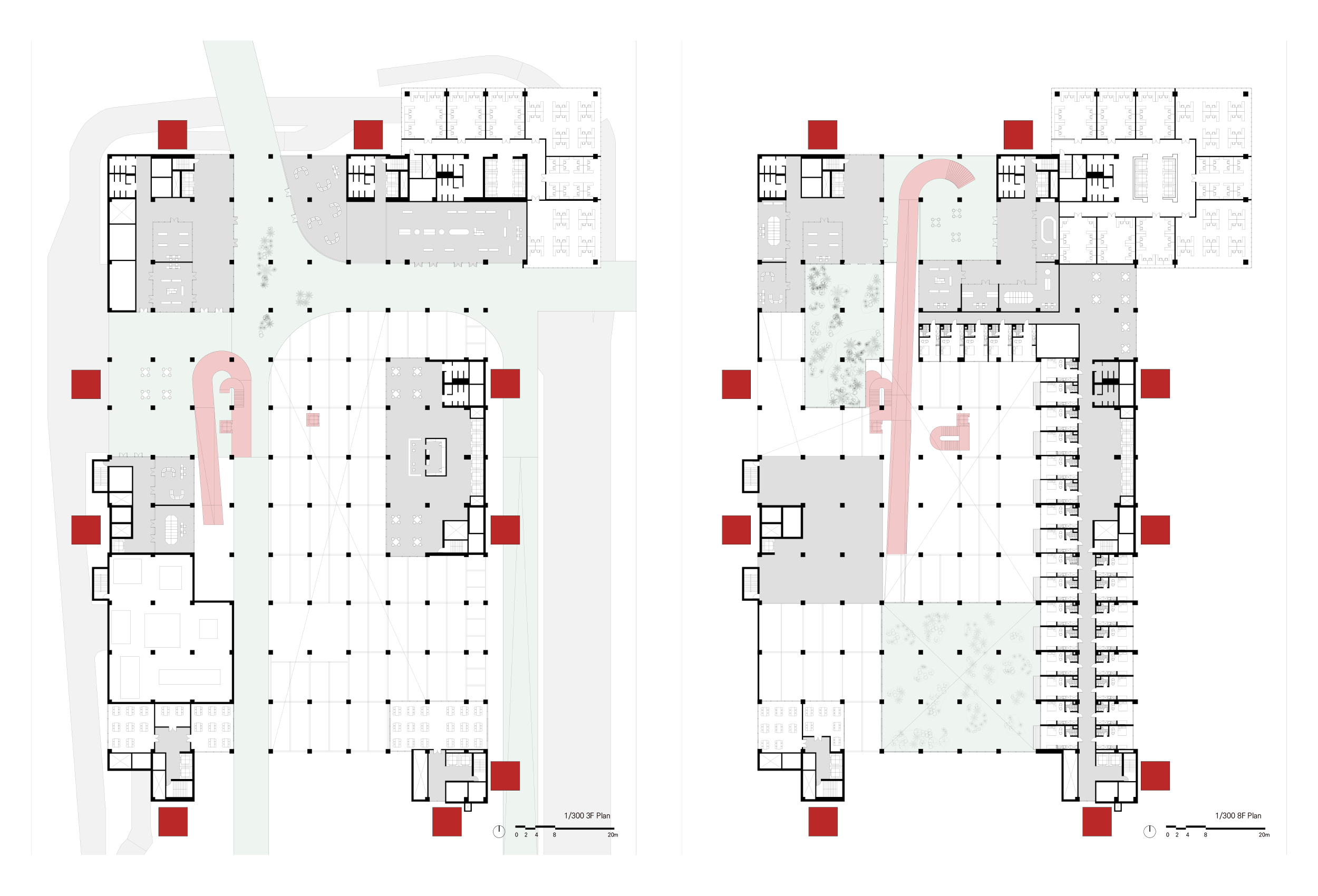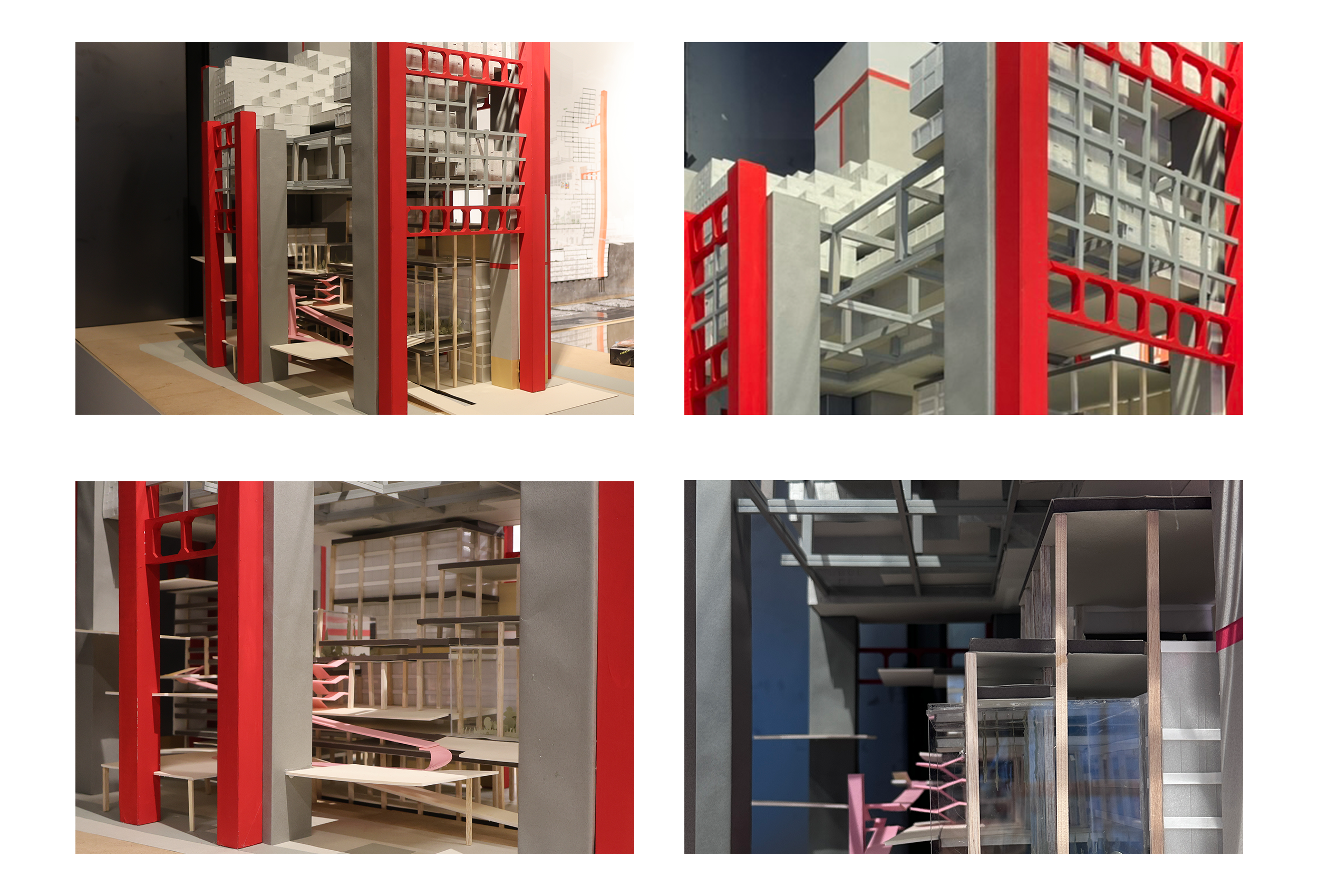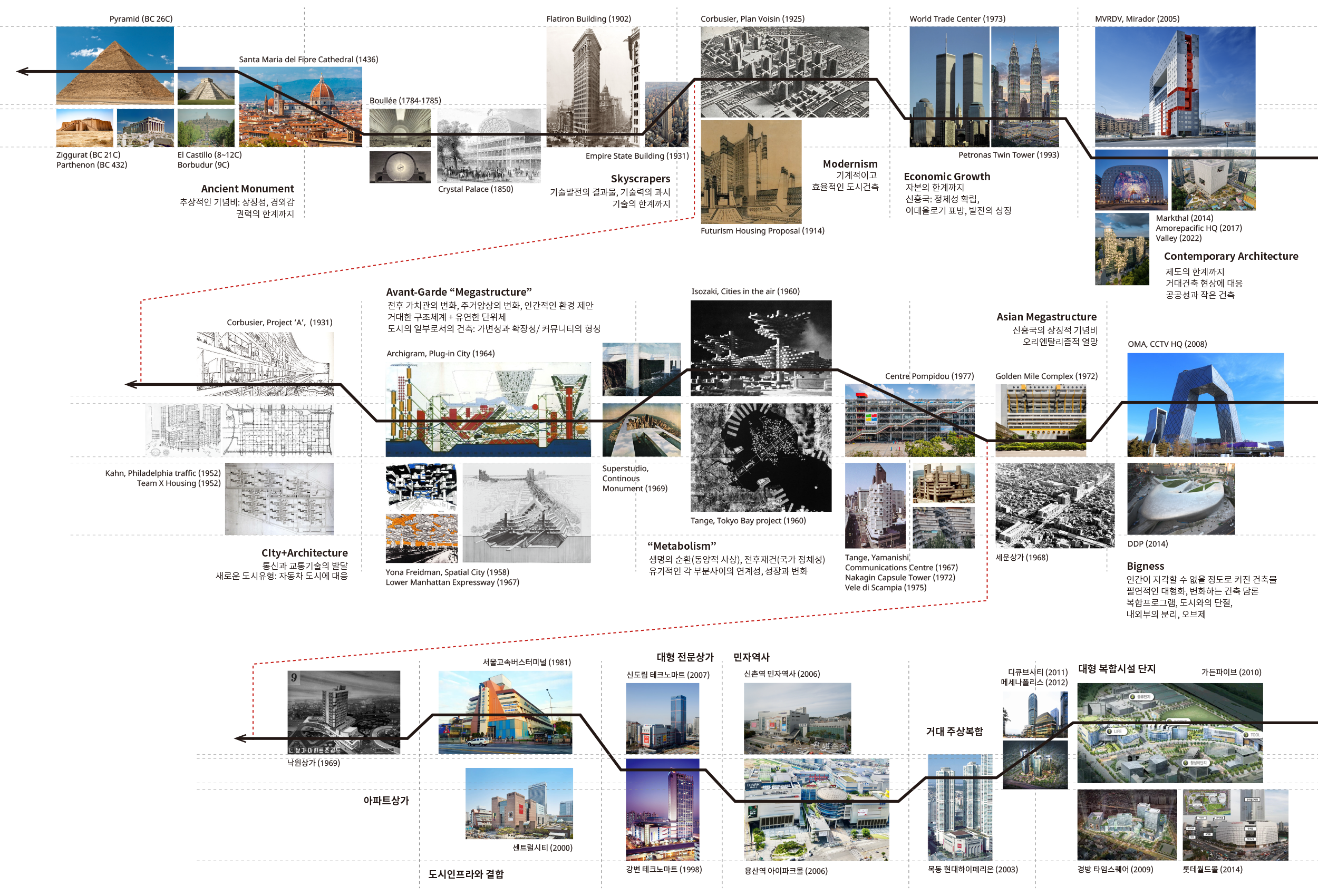박세준_테크노 젠가
신도림 테크노마트는 강변 테크노마트(1998)의 성공에 힘입어, 신도림 역세권에 세워진 제2의 테크노마트이다. 전자제품을 중심으로 상점들이 빽빽히 적층된 "테마상가"인 동시에, 각종 문화시설을 포함하고 있는 복합상업시설이기도 하다. 그러나 전자상거래의 발달, 경기침체, 팬데믹을 비롯한 여러 시대적 변화를 따라가지 못한 테크노마트는 현재 저조한 방문객 수와 높은 공실률 문제를 안고 있다. 물건을 판매할 공간만 있으면 충분했던 과거와는 다르게, 사람들은 더 이상 특별한 경험을 제공하지 않는 판매시설을 잘 방문하지 않는다.
사용환경이나 변화 가능성보다는 효율을 우선시한 고밀적층 설계로 인해 테크노마트의 공간적인 잠재력은 몹시 낮다. 건물의 기능을 담당하는 실들이 건물의 외벽을 따라 두르기 때문에 내부의 상업공간에는 햇빛과 외기가 잘 통하지 않는다. 또 층별로 정해진 판매 품목, 그리고 테마상가 특유의 업종제한은 프로그램적인 변모를 어렵게 만든다. 나아가 수천 명의 분할 소유주들 간 대립되는 이해관계, 이미 마구잡이로 적층된 규모로 인한 추가적인 개발이익의 소진은 건물의 변화를 크게 저해시킨다.
이처럼 신도림 테크노마트는 부동산 개발의 관점으로부터 다소 무책임하게 탄생하여, 손쓸 수 없이 낙후되어가고 있다. 에너지, 자원, 그리고 한정된 우리 지구의 땅을 고려했을 때 이는 크나큰 낭비가 아닐 수 없다. 이 프로젝트는 도심 한복판에서 마비되어버린 테크노마트, 그리고 이와 유사한 방식으로 무분별하게 지어진 수많은거대 건축물들을 방치할 수도, 허물 수도 없는 현실에 대한 문제의식 속에서 시작한다.
기존의 작동하는 설비를 최대한 활용하되, 반복되는 기둥-보 구조를 따라 모듈 단위로 고밀 공간을 덜어내며 보이드를 형성한다. 과감하게 비워낸 보이드 내부로는 도시적 컨텍스트를 끌어들여, 도시의 경험을 거대구조물 안으로 확장시킨다. 도시민들에게 열리는 적층된 보이드에는 공원, 광장, 온실이 들어선 테마공원이 만들어진다. 기둥과 보, 다양한 식생, 그리고 보이드를 면한 각종 프로그램에서의 도시풍경이 어우러지는, 독특한 공간적 경험이 가능해진다. 나아가 이는 고밀적층 구조를 체험할 수 있는 반성적 장소이기도 하다.
그러나 보다 중요한 것은, 빼낸 만큼, 혹은 그 이상을 쌓아야만 작동가능한 현실을 직시하는 것이다. 대지를 벗어나지 않으면서 적층된 가치규모를 보존하기 위해, 스스로의 땅 내에서 들어올려 더 큰 면적과 개선된 공간을 기존 건물의 상부에 제공한다.
다만 작동 가능한 체계를 고려해줘야 한다. 거대한 구조체를 추가하여 상부에 얹을 수 있는 기반을 마련해주고, 하부의 유휴설비들로부터 설비 코어를 올려 필요한 기능들을 공급해준다. 기존의 소유주들은 더 높은 곳과 더 커진 면적을 갖게 되고, 건물 전반적인 공간의 질 역시 상승한다. 이때 채광과 환기를 고려한 폭과 규모를 설정하고, 빛이 들어오는 환경 등을 고려하여 하부와 공존가능하도록 쌓아올린다.
상부로 쌓여 올라가는 거대한 매스는 고밀적층된 하부를 개선하기 위해 불가피한, 그러나 최소의 방식이다.
Shindorim Techno Mart, established in the vicinity of Shindorim Station, is the second Techno Mart following the success of the Gangbyeon Techno Mart (1998). This complex commercial facility, densely packed with stores primarily selling electronic products, also includes various cultural amenities. However, the Techno Mart has not kept pace with various contemporary changes, such as the development of e-commerce, economic recession, and the pandemic. As a result, it currently faces issues of low visitor numbers and high vacancy rates. Unlike the past, when merely providing a space to sell products was sufficient, people nowadays do not frequent sales facilities that do not offer unique experiences.
Due to its high-density layered design, which prioritized efficiency over adaptability or potential for change, the spatial potential of Techno Mart is extremely low. The building’s functional rooms are arranged along the exterior walls, preventing sunlight and fresh air from reaching the internal commercial spaces. Additionally, the fixed sales categories on each floor and the business restrictions typical of themed shopping centers further hinder programmatic transformation. Furthermore, the conflicting interests among thousands of divided property owners and the exhaustion of additional development benefits due to the already haphazardly layered scale greatly impede the building’s transformation.
Shindorim Techno Mart, thus, was somewhat irresponsibly conceived from a real estate development perspective and is now becoming increasingly obsolete beyond remedy. Considering energy, resources, and the limited land of our planet, this represents a significant waste. This project begins with the awareness of the reality that the paralyzed Techno Mart in the heart of the city, and many similarly indiscriminately constructed megastructures, cannot simply be abandoned or demolished.
While maximizing the use of existing operational facilities, high-density spaces are selectively removed along the repetitive column-beam structure to create voids. Boldly cleared voids draw in urban contexts, extending urban experiences within the megastructure. These layered voids, open to urban residents, transform into themed parks featuring parks, plazas, and greenhouses. This unique spatial experience, combining columns, beams, diverse vegetation, and various programs facing the voids, also serves as a reflective place to experience the high-density layered structure.
However, more importantly, it is necessary to face the reality that as much or even more must be added than what is removed to maintain functionality. To preserve the accumulated value scale while staying within the site, larger and improved spaces are provided atop the existing building by elevating within its own ground.
However, a workable system must be considered. A foundation is prepared to add a massive structure on top, raising the necessary facilities core from the idle lower facilities to supply essential functions. Existing owners gain higher and larger spaces, and the overall quality of the building's space improves. The added structures are designed with widths and scales considering lighting and ventilation, ensuring coexistence with the lower parts.
The massive mass rising upwards is an unavoidable yet minimal method to improve the high-density layered lower structure.

